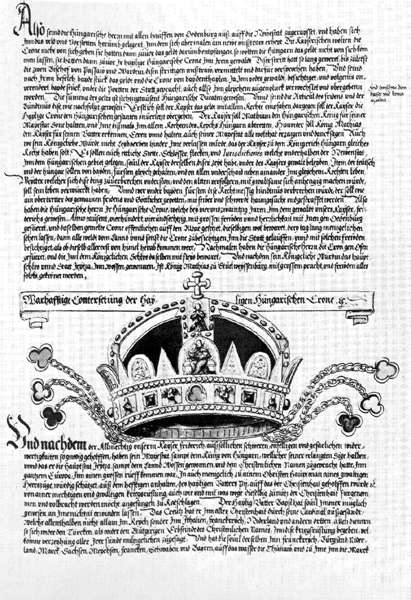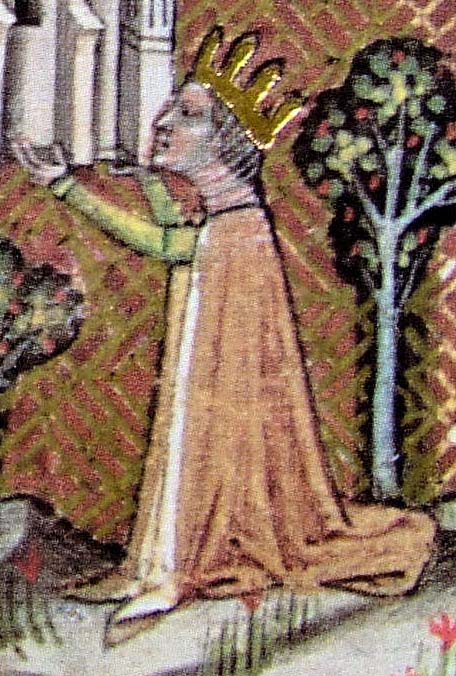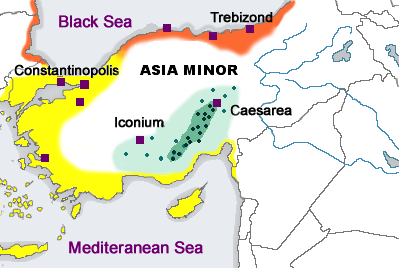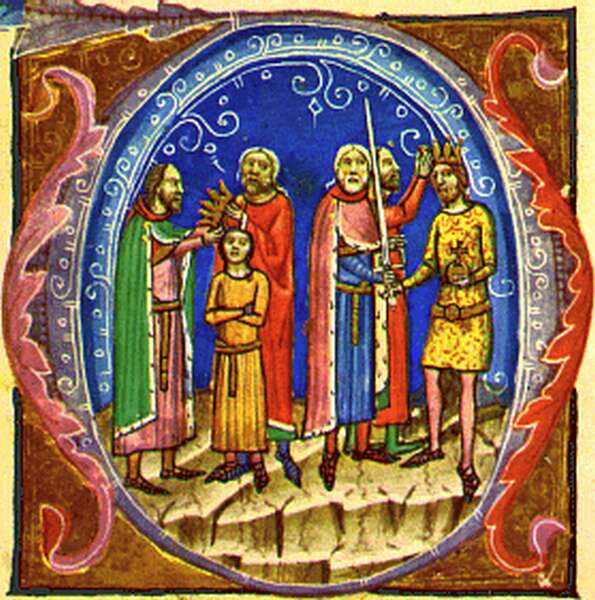|
Synadene
Synadene ( el, Συναδηνή, hu, Szünadéné) was a Byzantine Greek woman who briefly acted as queen consort of Hungary, probably in the 1070s. She was most likely married to King Géza I. Husband's identity Synadene's first name is unknown. Her father was the Byzantine commander Theodoulos Synadenos, while her mother was a sister of Nikephoros III Botaneiates, Byzantine emperor since 1078. ''Scylitzes Continuatus'', believed to have been written by Synadene's compatriot John Skylitzes, states that "the emperor had given his niece the Synadene, daughter of Theodoulos Synadenos, to the krales of Hungary for a wife; upon his death she returned to Byzantium." The king's name, much like her own, is not mentioned. An important clue to the identity of Synadene's husband lies in one of the enamel plaques contained in the Holy Crown of Hungary, which depicts a man identified as "Géza, faithful king of the Hungarians". Géza I's death on 25 April 1077 corresponds to Skylitzes's ... [...More Info...] [...Related Items...] OR: [Wikipedia] [Google] [Baidu] |
Géza I Of Hungary
Géza I (; hu, I. Géza; 104025 April 1077) was King of Hungary from 1074 until his death. He was the eldest son of King Béla I. His baptismal name was Magnus. With German assistance, Géza's cousin Solomon acquired the crown when his father died in 1063, forcing Géza to leave Hungary. Géza returned with Polish reinforcements and signed a treaty with Solomon in early 1064. In the treaty, Géza and his brother Ladislaus acknowledged the rule of Solomon, who granted them their father's former duchy, which encompassed one-third of the Kingdom of Hungary. Géza closely cooperated with Solomon, but their relationship became tense from 1071. The king invaded the duchy in February 1074 and defeated Géza in a battle. However, Géza was victorious at the decisive battle of Mogyoród on 14 March 1074. He soon acquired the throne, although Solomon maintained his rule in the regions of Moson and Pressburg (present-day Bratislava, Slovakia) for years. Géza initiated peace negotia ... [...More Info...] [...Related Items...] OR: [Wikipedia] [Google] [Baidu] |
Synadenos
Synadenos ( el, Συναδηνός), feminine form Synadene (Συναδηνή), was the name of a middle and late Byzantine aristocratic family, hailing from Synada in Phrygia. The family name is attested in the 9th/10th century seal, but the first known family member is Philetos Synadenos, ''krites'' of Tarsus ca. 1000/6. During the 11th and 12th centuries, several family members appear as military commanders, connected to the great aristocratic families of Botaneiates and Komnenos; thus a member of the family was given as wife to the Hungarian king Géza I by Nikephoros III Botaneiates, Basil Synadenos was governor of Dyrrhachium in the 1040s, and Andronikos Synadenos was governor of several provinces under Manuel I Komnenos, including Cyprus. In the Empire of Nicaea, the Synadenoi were members of the aristocratic opposition to the ruling Laskaris dynasty. The family reached is peak under the Palaiologan emperors in the late 13th and first half of the 14th century: John Sy ... [...More Info...] [...Related Items...] OR: [Wikipedia] [Google] [Baidu] |
Judith Of Swabia
Judith of Swabia ( hu, Sváb Judit, pl, Judyta Szwabska, Judyta Salicka; Summer 1054 – 14 March ca. 1105?), a member of the Salian dynasty, was the youngest daughter of Emperor Henry III from his second marriage with Agnes of Poitou. By her two marriages she was Queen of Hungary from 1063 to 1074 and Duchess of Poland from 1089 to 1102. Early life Born probably at the Imperial Palace of Goslar, Judith was the youngest of the six children born to Emperor Henry III and Empress Agnes. Soon after her birth on 9 April 1054, Judith was betrothed to Philip, eldest son of King Henry I of France. However, after the death of Emperor Henry III on 5 October 1056, with Empress Agnes acting as regent on behalf of her minor son, King Henry IV, the engagement was broken in September 1058, when a peace treaty was concluded with King Andrew I of Hungary. Emperor Henry III had waged two unsuccessful campaigns against Hungary in 1051 and 1052, whereafter Pope Leo IX arranged an agreement. As a p ... [...More Info...] [...Related Items...] OR: [Wikipedia] [Google] [Baidu] |
Adelaide Of Rheinfelden
Adelaide of Rheinfelden (or Adelaide of Swabia) (german: Adelheid) (1060s – May 1090), was Queen Consort of Hungary by marriage to King Ladislaus I of Hungary. Life Adelaide was born circa 1065 to Rudolf of Rheinfelden, duke of Swabia and German anti-king, and his second wife, Adelaide of Savoy. Her maternal aunt was Bertha of Savoy, who was married to Henry IV of Germany. Around 1077/8 Adelaide married Ladislaus I of Hungary, a member of the Árpád dynasty. Ladislaus agreed to support Rudolf in his struggle for the throne against Henry IV of Germany. In 1079 Adelaide's mother died, followed in 1080 by her father, who fell at the Battle of Elster. In 1081 Pope Gregory VII wrote to Adelaide, urging her to encourage her husband to support monasteries and be generous to the poor and the weak. Adelaide died in May 1090; her husband outlived her by 5 years. She was buried in Veszprém, where her gravestone remains. Issue Adelaide had two children: * Piroska of Hungary Ire ... [...More Info...] [...Related Items...] OR: [Wikipedia] [Google] [Baidu] |
Holy Crown Of Hungary
The Holy Crown of Hungary ( hu, Szent Korona; sh, Kruna svetoga Stjepana; la, Sacra Corona; sk, Svätoštefanská koruna , la, Sacra Corona), also known as the Crown of Saint Stephen, named in honour of Saint Stephen I of Hungary, was the coronation crown used by the Kingdom of Hungary for most of its existence; kings have been crowned with it since the twelfth century. The Crown symbolized the King's authority over the Lands of the Hungarian Crown (the Carpathian Basin), and it was a key mark of legitimacy. Through the history of Hungary, more than fifty kings were crowned with it, until 1916 and the last king Charles IV. The only kings not so crowned were Wladyslaw I, John Sigismund Zápolya and Joseph II. The enamels on the crown are mainly or entirely Byzantine work, presumed to have been made in Constantinople (present-day Istanbul, Turkey) in the 1070s. The crown was presented by the Byzantine Emperor Michael VII Doukas to the King Géza I of Hungary; both are d ... [...More Info...] [...Related Items...] OR: [Wikipedia] [Google] [Baidu] |
List Of Hungarian Consorts
This is a list of the queens consorts of Hungary ( hu, királyné), the consorts of the kings of Hungary. After the extinction of the Árpád dynasty and later the Angevin dynasty, the title of King of Hungary has been held by a monarch outside of Hungary with a few exceptions. After 1526, the title of Queen of Hungary belonged to the wife of the Habsburg Emperors who were also King of Hungary. Queens of Hungary also held the titles after 1526: Holy Roman Empress (later Empress of Austria) and Queen consort of Bohemia. Since Leopold I, all kings of Hungary used the title of Apostolic King of Hungary the title given to Saint Stephen I by the Pope and their wives were styled as Apostolic Queens of Hungary. The title lasted just a little over nine centuries, from 1000 to 1918. The Kingdom of Hungary also had two queens regnant (''királynő'') who were crowned as kings: Maria I and Maria II Theresa. Grand Princesses of the Hungarians Queens consort of Hungary House ... [...More Info...] [...Related Items...] OR: [Wikipedia] [Google] [Baidu] |
Byzantine Greek
Medieval Greek (also known as Middle Greek, Byzantine Greek, or Romaic) is the stage of the Greek language between the end of classical antiquity in the 5th–6th centuries and the end of the Middle Ages, conventionally dated to the Ottoman conquest of Constantinople in 1453. From the 7th century onwards, Greek was the only language of administration and government in the Byzantine Empire. This stage of language is thus described as Byzantine Greek. The study of the Medieval Greek language and literature is a branch of Byzantine studies, the study of the history and culture of the Byzantine Empire. The beginning of Medieval Greek is occasionally dated back to as early as the 4th century, either to 330 AD, when the political centre of the Roman Empire was moved to Constantinople, or to 395 AD, the division of the empire. However, this approach is rather arbitrary as it is more an assumption of political, as opposed to cultural and linguistic, developments. Indeed, by this tim ... [...More Info...] [...Related Items...] OR: [Wikipedia] [Google] [Baidu] |
Nikephoros III Botaneiates
Nikephoros III Botaneiates, Latinized as Nicephorus III Botaniates ( el, Νικηφόρος Βοτανειάτης, 1002–1081), was Byzantine emperor from 7 January 1078 to 1 April 1081. He was born in 1002, and became a general during the reign of Byzantine Emperor Constantine IX Monomachos, serving in the Pecheneg revolt of 1048–1053. His actions in guiding his forces away from the Pechenegs following the Battle of Zygos Pass, in which they suffered eleven days of harassment before finally reaching the Byzantine city of Adrianople, attracted the attention of fellow officers, and he received the title of '' magistros'' as a reward. Nikephoros served in the revolt of Isaac I Komnenos against the Byzantine Emperor Michael VI Bringas, leading forces at the decisive Battle of Petroe. Under the Emperor Constantine X Doukas he was made '' doux'' of Thessalonica, where he remained until 1065, when he was reassigned as ''doux'' of Antioch. While ''doux'' of Antioch, ... [...More Info...] [...Related Items...] OR: [Wikipedia] [Google] [Baidu] |
John Skylitzes
John Skylitzes, commonly Latinized as Ioannes, la, Johannes, label=none, la, Iōannēs, label=none Scylitzes ( el, Ἰωάννης Σκυλίτζης, ''Iōánnēs Skylítzēs'', or el, Σκυλίτση, ''Skylítsē'', label=none ; la, Ioannes Scyllitzes, , la, Scylitza, label=none , or la, Schillizzi, label=none ; early 1040s – after 1101), was a Byzantine historian of the late 11th century. Life Very little is known about his life. The title of his work records him as a '' kouropalatēs'' and a former ''droungarios'' of the ''Vigla'', whereby he is usually identified with a certain John Thrakesios. His major work is the ''Synopsis of Histories'' ( el, Σύνοψις Ἱστοριῶν ), which covers the reigns of the Byzantine emperors from the death of Nikephoros I in 811 to the deposition of Michael VI in 1057; it continues the chronicle of Theophanes the Confessor. There is a continuation of this work, known as ''Scylitzes Continuatus'', covering 1057 ... [...More Info...] [...Related Items...] OR: [Wikipedia] [Google] [Baidu] |
King Of Hungary
The King of Hungary ( hu, magyar király) was the ruling head of state of the Kingdom of Hungary from 1000 (or 1001) to 1918. The style of title "Apostolic King of Hungary" (''Apostoli Magyar Király'') was endorsed by Pope Clement XIII in 1758 and used afterwards by all Monarchs of Hungary. The term "King of Hungary" is typically capitalized only as a title applied to a specific person; however, within this article, the terms "Kings of Hungary" or "Junior Kings" (etc.) are also shown in capital letters, as in the manner of philosophical writing which capitalizes concepts such as Truth, Kindness and Beauty. Establishment of the title Before 1000 AD, Hungary was not recognized as a kingdom and the ruler of Hungary was styled Grand Prince of the Hungarians. The first King of Hungary, Stephen I. was crowned on 25 December 1000 (or 1 January 1001) with the crown Pope Sylvester II had sent him and with the consent of Otto III, Holy Roman Emperor. Fo ... [...More Info...] [...Related Items...] OR: [Wikipedia] [Google] [Baidu] |
Ladislaus I Of Hungary
Ladislaus I ( hu, László, hr, Ladislav, sk, Ladislav, pl, Władysław; 1040 – 29 July 1095), also known as Saint Ladislas, was King of Hungary from 1077 and King of Croatia from 1091. He was the second son of King Béla I of Hungary and Richeza (or Adelaide) of Poland. After Béla's death in 1063, Ladislaus and his elder brother, Géza, acknowledged their cousin Solomon as the lawful king in exchange for receiving their father's former duchy, which included one-third of the kingdom. They cooperated with Solomon for the next decade. Ladislaus's most popular legend, which narrates his fight with a "Cuman" (a Turkic nomad marauder) who abducted a Hungarian girl, is connected to this period. The brothers' relationship with Solomon deteriorated in the early 1070s, and they rebelled against him. Géza was proclaimed king in 1074, but Solomon maintained control of the western regions of his kingdom. During Géza's reign, Ladislaus was his brother's most influential adviser. ... [...More Info...] [...Related Items...] OR: [Wikipedia] [Google] [Baidu] |
Solomon Of Hungary
Solomon, also Salomon ( hu, Salamon; 1053–1087) was King of Hungary from 1063. Being the elder son of Andrew I, he was crowned king in his father's lifetime in 1057 or 1058. However, he was forced to flee from Hungary after his uncle, Béla I, dethroned Andrew in 1060. Assisted by German troops, Solomon returned and was again crowned king in 1063. On this occasion he married Judith, sister of Henry IV, Holy Roman Emperor. In the following year he reached an agreement with his cousins, the three sons of Béla I. Géza, Ladislaus and Lampert acknowledged Solomon's rule, but in exchange received one-third of the kingdom as a separate duchy. In the following years, Solomon and his cousins jointly fought against the Czechs, the Cumans and other enemies of the kingdom. Their relationship deteriorated in the early 1070s and Géza rebelled against him. Solomon could only maintain his rule in a small zone along the western frontiers of Hungary after his defeat in the Battle of Mogyoród ... [...More Info...] [...Related Items...] OR: [Wikipedia] [Google] [Baidu] |







.jpg)